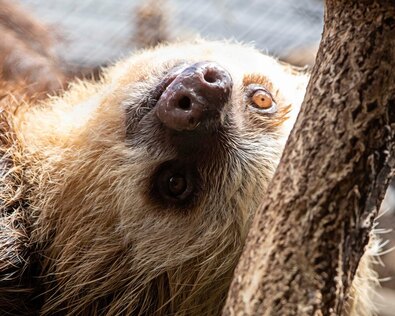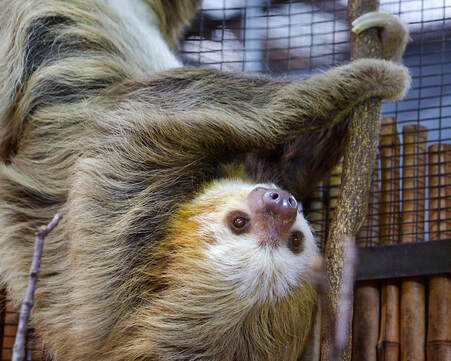Two-Toed Sloth (Choloepus hoffmanni)

Physical Description: Hoffmann's Two-Toed Sloths are small, usually 2 to 2.5 feet tall weighing anywhere from 9 to 20 pounds. They have brownish-greenish dense fur that acquires its color from two species of blue-green algae that grow in the fur and provide exceptional camouflage. They possess compact tailless bodies, rounded heads and lighter fur around their large eyes. Sloths are the only mammals whose hair grows in the opposite direction from the hair of other mammals. To accommodate their upside lifestyle, the hair parts in the middle of the belly and grows upward toward the back. The hair on the face points upward, too. This allows water to run off during rainstorms.
They have long legs with extremely long two-clawed forefeet (and three-clawed hind feet) that aid them in climbing high above the rainforest floor.
They have very poor eyesight and hearing and rely almost entirely on their senses of touch and smell. They are solitary and nocturnal.
Hoffman’s Two-toed Sloths have an extremely slow metabolism and have the lowest variable body temperature of any mammal. Unlike most mammals, their body temperature and metabolism will fluctuate throughout the day according to environmental temperatures. They live almost their entire lives upside down in the treetops and because of their slow metabolism they only have to climb down to the ground once a week to go to the bathroom.
They have long legs with extremely long two-clawed forefeet (and three-clawed hind feet) that aid them in climbing high above the rainforest floor.
They have very poor eyesight and hearing and rely almost entirely on their senses of touch and smell. They are solitary and nocturnal.
Hoffman’s Two-toed Sloths have an extremely slow metabolism and have the lowest variable body temperature of any mammal. Unlike most mammals, their body temperature and metabolism will fluctuate throughout the day according to environmental temperatures. They live almost their entire lives upside down in the treetops and because of their slow metabolism they only have to climb down to the ground once a week to go to the bathroom.

Habitat: They live in rainforest canopies.
Range: They make their home in Central and South American tropical forests.
Diet: Hoffmann's Two-Toed Sloths are herbivores. They eat a wide variety of leaves, tender shoots, moss and fruit. They get all the water they need from the plants and fruits they eat. Sloths are very important propagators of tropical plants. Several species of plants germinate only after they have passed through the sloths' digestive system.
Lifespan: Average life span is 20 years in the wild and 30 or more years in human care.
Social Structure: Females give birth to a single offspring, which weighs about 1 pound. The young sloth clings onto its mother’s chest region and nurses. The young can hang upside down within 20 to 25 days but continue to nurse for the first five months of life. The young may associate with their mothers for the first two years before setting out on their own in their rainforest home. Females may gather periodically. Males are solitary.
Status: Least Concern1
Other: A common mistake is referring to them as being related to monkeys because of their fur and long arms but they are actually more closely related to anteaters and armadillos.
1 https://www.iucnredlist.org/species/4778/210443596
Range: They make their home in Central and South American tropical forests.
Diet: Hoffmann's Two-Toed Sloths are herbivores. They eat a wide variety of leaves, tender shoots, moss and fruit. They get all the water they need from the plants and fruits they eat. Sloths are very important propagators of tropical plants. Several species of plants germinate only after they have passed through the sloths' digestive system.
Lifespan: Average life span is 20 years in the wild and 30 or more years in human care.
Social Structure: Females give birth to a single offspring, which weighs about 1 pound. The young sloth clings onto its mother’s chest region and nurses. The young can hang upside down within 20 to 25 days but continue to nurse for the first five months of life. The young may associate with their mothers for the first two years before setting out on their own in their rainforest home. Females may gather periodically. Males are solitary.
Status: Least Concern1
Other: A common mistake is referring to them as being related to monkeys because of their fur and long arms but they are actually more closely related to anteaters and armadillos.
1 https://www.iucnredlist.org/species/4778/210443596






